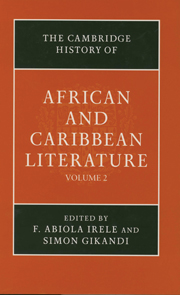Book contents
- Frontmatter
- 23 East African literature in English
- 24 Anglophone literature of Central Africa
- 25 West African literature in English: beginnings to the mid-seventies
- 26 South African literature in English
- 27 African literature in French: sub-Saharan Africa during the colonial period
- 28 North African literature in French
- 29 Francophone literatures of the Indian Ocean
- 30 African literature in Spanish
- 31 African literature in Portuguese
- 32 Popular literature in Africa
- 33 Caribbean literature in French: origins and development
- 34 Caribbean literature in Spanish
- 35 Anglophone Caribbean literature
- 36 The Harlem Renaissance and the Negritude movement
- 37 Postcolonial Caribbean identities
- 38 African literature and post-independence disillusionment
- 39 “Postcolonial” African and Caribbean literature
- 40 Modernism and Postmodernism in African literature
- Index
- References
34 - Caribbean literature in Spanish
Published online by Cambridge University Press: 28 March 2008
- Frontmatter
- 23 East African literature in English
- 24 Anglophone literature of Central Africa
- 25 West African literature in English: beginnings to the mid-seventies
- 26 South African literature in English
- 27 African literature in French: sub-Saharan Africa during the colonial period
- 28 North African literature in French
- 29 Francophone literatures of the Indian Ocean
- 30 African literature in Spanish
- 31 African literature in Portuguese
- 32 Popular literature in Africa
- 33 Caribbean literature in French: origins and development
- 34 Caribbean literature in Spanish
- 35 Anglophone Caribbean literature
- 36 The Harlem Renaissance and the Negritude movement
- 37 Postcolonial Caribbean identities
- 38 African literature and post-independence disillusionment
- 39 “Postcolonial” African and Caribbean literature
- 40 Modernism and Postmodernism in African literature
- Index
- References
Summary
The literatures of the three hispanophone islands of the Caribbean – Cuba, the Dominican Republic, and Puerto Rico – are the oldest in the region. Their origins can be traced back to an Arawak oral tradition rich in myth and legend – gathered in all its vividness by Spanish Friar Ramon Pané in his Relación acerca de las antigüedades des los indios, las cuales, con diligencia, como hombre que sabe su idioma, recogió por mandato del Almirante (1571) (An Account of the Antiquities of the Indians, Gathered Diligently by a Man Who Knows Their Language; Chronicles of the New World Encounters, 1999) – that speaks of a worldview centered on a harmonious relationship between religion, culture, politics, and patterns of work and exchange. Pané, who lived in Hispaniola from 1494 to 1499, gathered a rich trove of myths, beliefs, and aboriginal religious practices that constitute most of what we know of the Amerindian lore of the Caribbean. Together with the many descriptions found in Spanish chronicles of the dancing and singing rituals known as areitos, through which the Taínos recorded their history and reconstructed through drama salient episodes of everyday life, they offer glimpses of rich cultural traditions lost through the impact of warfare and the virgin soil epidemics that decimated the aboriginal population of the Caribbean. The picture they convey, of a society dependent on a simple economy of subsistence agriculture and fishing, survived the devastation and environmental assault of European conquest and colonization to make an important contribution to Puerto Rican, Dominican and, to a lesser extent, Cuban rural cultures, laying the foundation for traditions of resistance that would later serve as a counter world to the economy of the plantation.
- Type
- Chapter
- Information
- The Cambridge History of African and Caribbean Literature , pp. 670 - 710Publisher: Cambridge University PressPrint publication year: 2000
References
- 1
- Cited by

